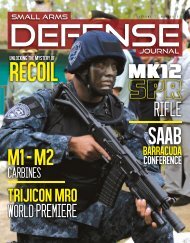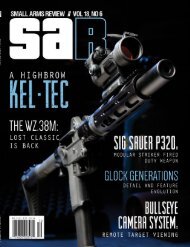SAR 20#2
Create successful ePaper yourself
Turn your PDF publications into a flip-book with our unique Google optimized e-Paper software.
ful to keep the barrel delay spring<br />
and pin from becoming lost.<br />
6. Remove the barrel through the<br />
front of the slide.<br />
7. No further disassembly is needed<br />
or recommended.<br />
Despite being a proprietary cartridge<br />
for a military weapon, those who carried<br />
the M1 carbine became fond of the<br />
handy weapon. Interest was renewed<br />
during the 1960s when surplus carbines<br />
were offered through the NRA for<br />
$17.00. When the original supply of military<br />
issue carbines dried up, there were<br />
several commercial companies that<br />
introduced aftermarket copies. Before<br />
long several hand guns were produced,<br />
further increasing interest in the little .30<br />
caliber round.<br />
During World War II there were four<br />
experimental Smith and Wesson revolvers<br />
made for the round, the cartridges<br />
were loaded on half-moon clips. More<br />
modern handguns include the Ruger<br />
Blackhawk revolver introduced in 1968,<br />
was revised in 1973 as the New Model<br />
Blackhawk, and the Dakota single action<br />
army revolver in .30 carbine made in Italy.<br />
Also available in .30 carbine caliber<br />
was the Thompson/Center single-shot<br />
pistol, which is no longer offered by the<br />
manufacturer. Marlin briefly offered their<br />
.30 carbine caliber Model 62 Levermatic<br />
rifle from 1966 to 1969. All of the aforementioned<br />
firearms helped sustain interest<br />
in the cartridge.<br />
Origins of the .30 Caliber<br />
Carbine Cartridge<br />
The lightweight U.S. caliber .30 carbine<br />
emerged during World War II from<br />
the need to better arm soldiers who<br />
were rear echelon support troops. The<br />
carbine was conceived to provide an offensive<br />
as well as a defensive weapon<br />
that would have far more range than a<br />
pistol. The semi-automatic carbine offered<br />
a 300 yard range and a 15 round<br />
magazine.<br />
Cartridge, Carbine, Caliber .30<br />
Winchester developed a new midrange<br />
cartridge to be used in the new<br />
“light rifle”. The cartridge was designated<br />
as, Cartridge, Carbine, Caliber .30<br />
M1. The early characteristics of the new<br />
cartridge were;<br />
a. Bullet weight: 110 grains.<br />
b. Charge weight: 14.5 grains<br />
of IMR 4227<br />
c. Primer: Winchester No. 116<br />
d. Pressure: 31,000 PSI<br />
e. Muzzle velocity 1,860 feet<br />
per second.<br />
The cartridge was approved as<br />
Standard on 30 September 1941. The<br />
Ordnance Department awarded contracts<br />
to the Western Cartridge Company,<br />
Winchester Repeating Arms,<br />
Remington Arms Company, Lake City<br />
Ordnance Plant and the Kings Mills<br />
<strong>SAR</strong> Vol. 20, No. 2 66 MARCH 2016









